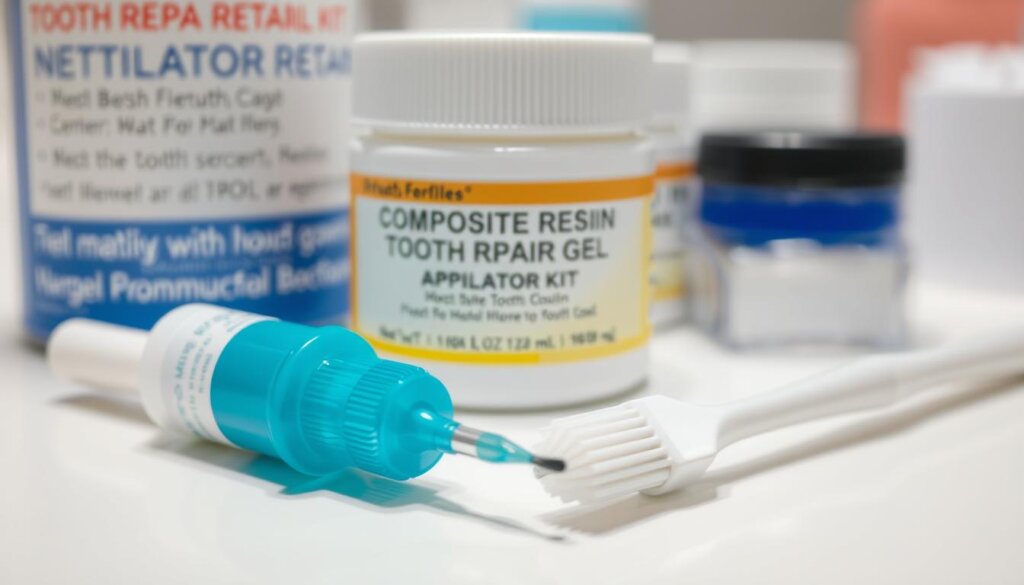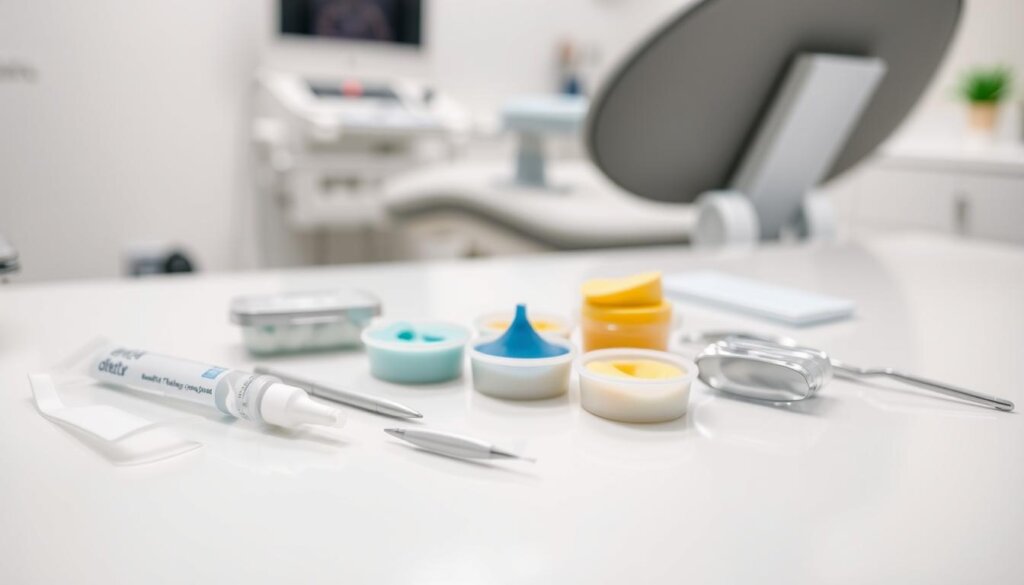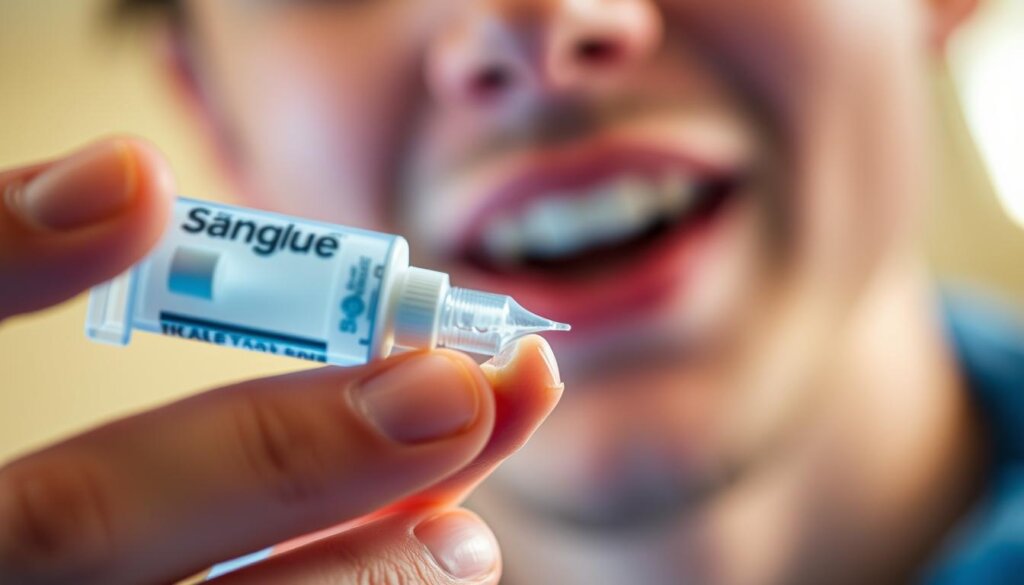Superglue for Broken Teeth: Safe or Risky?
Every year, over five million teeth are knocked out, according to the International Association of Dental Traumatology. Many wonder, “Can I use temporary repair kits or superglue on a broken tooth?” when they get a sudden crack or chip.
Experts caution about superglue’s chemicals, like formaldehyde, which can be toxic or cause infections. The question about using superglue or temporary repair kits raises concerns about quick fixes that might harm more than help. We aim to offer scientific advice, focusing on safer dental solutions for urgent situations.
Key Takeaways
- Over five million teeth are lost each year worldwide.
- Superglue chemicals can spark toxicity risks.
- Improper bonding may increase infection chances.
- Temporary repair kits offer short-term relief.
- Professional attention remains the safest option.
- Research-driven solutions help prevent lasting damage.
Introduction to Dental Emergencies
Unexpected fractures or chips can turn simple moments into urgent needs. Can a chipped tooth become a serious problem? Many wonder this when they face oral trauma. Knowing what to do early is key for both patients and experts.
Common Causes of Broken Teeth
Sports accidents, falls, or biting hard foods often cause tooth cracks. Even normal wear can weaken teeth until they break. Some breaks are just on the surface, but others expose sensitive inner layers that need quick checks.
Importance of Immediate Care
Quick action can prevent bigger problems. A temporary fix for a broken tooth can ease pain until you see a dentist. Getting help fast lowers the chance of infection and makes treatments simpler and less expensive. Regular dental visits and protective habits help keep teeth safe from harm.
Understanding Temporary Repair Kits
Emergency fixes are key when teeth are damaged. Over-the-counter products are popular for quick relief. They offer a safe way to fix teeth before seeing a dentist.
What Are Temporary Repair Kits?
These kits have materials for minor fixes or filling replacements. They usually include:
- Pre-measured dental cement
- Applicators
- Mixing tools
Each part helps seal the damage. This stops food and bacteria from getting in.
How Do They Work?
The cement bonds to the tooth, creating a protective layer. It seals the tooth until you can see a dentist. This barrier gives quick relief and keeps the tooth in place.
Effectiveness and Limitations
These kits offer fast support, but misuse can lead to problems. They’re not for complex issues or hidden decay. Dentists are needed for a full fix. Temporary kits are a stopgap until a dentist can assess the damage.
The Risks of Using Superglue on Teeth
Using superglue for tooth troubles might seem like a fast solution. But, it contains chemicals that are harmful in the mouth. People often turn to it to fix a broken tooth. This can lead to worries about poisoning, lasting harm, and bad reactions.

Toxicity and Health Concerns
Many superglue formulas have formaldehyde or acetic acid. These can irritate mouth tissues if swallowed or inhaled. They can also stay on tooth enamel, upsetting the balance of saliva.
Small particles can increase the risk of infection or gum inflammation.
Potential for Further Damage
Over time, saliva weakens the superglue bond, causing uneven surfaces or gaps. This can lead to more pain near the gum or make existing breaks worse. Trapped debris can also cause plaque buildup, leading to more problems.
Allergic Reactions and Sensitivity
Some people experience redness, swelling, or throbbing when exposed to these harsh chemicals. This shows superglue is not safe for the mouth. It can cause sharp pain and sensitivity, making daily life hard.
This highlights the need for safe products and quick professional help. Good emergency dental care aims to protect health without risks.
Comparing Superglue and Temporary Kits
Many people look for a quick fix for a chipped or cracked tooth. Superglue seems like an easy choice, but it can harm your mouth. Temporary repair kits are safer and less likely to cause infection.
Pros and Cons of Each Option
Superglue is easy to use, but it might not last long. Kits for DIY tooth repair have ingredients that soothe your mouth. Here’s a quick comparison:
| Factor | Superglue | Temporary Repair Kit |
|---|---|---|
| Composition | Industrial adhesive | Zinc-oxide eugenol or similar |
| Biocompatibility | Risk of gum irritation | Gentle on oral tissues |
| Longevity | Unpredictable under moisture | Short-term but more stable |
| Risk of Infection | Higher likelihood | Reduced incidence |
When to Choose One Over the Other
Think about how bad the break is before you choose. A small chip might be fixed with a filling compound. But big damage needs a dentist. For a safer DIY tooth repair, use a kit made for your mouth.
Expert Opinions on DIY Dental Repairs
Many experts are cautious about at-home fixes. They say using adhesives or patches might hide bigger dental problems. Is it a real fix or just a quick cover-up?
Some dentists warn that DIY repairs can make people wait too long for real help. A broken tooth often means there’s something deeper wrong. This needs a dentist’s careful check.
Dental Professionals’ Viewpoint
Dentists have several worries about home treatments:
- Some glues might be toxic.
- Improper use can cause biting problems.
- Untreated cracks or decay can lead to infections.
Interviews with Dentists
The American Dental Association advises getting expert advice before trying DIY fixes. Studies show that ignoring deeper problems can lead to long-term issues.
Dr. Clara Diamond says, “We often find hidden damage when patients come in. Early treatment is key for good results.”
Many dentists agree that a quick visit can prevent big problems. They say adhesives can’t fix everything. A dentist’s help is needed for a proper fix.
Proper Usage of Repair Kits
Fixing a broken tooth needs careful steps to keep it stable. Many see these kits as a quick fix, like tooth bonding alternatives. They offer a temporary solution without needing a big procedure. Learning how to use them right can make you feel better and help you get to the dentist sooner.

Step-by-Step Guide for Temporary Repairs
- Clean the Workspace: Wash your hands well, and rinse the tooth to get rid of dirt.
- Minimize Moisture: Gently pat the area with sterile gauze or tissue. Too much saliva can stop the adhesive from sticking well.
- Mix the Cement: Mix the powder and liquid as the kit says. A smooth mix makes it last longer.
- Secure the Material: Place the mix on the broken area and press gently. Make sure it’s straight.
- Let It Set: Wait for the time suggested to make sure it’s stuck well before checking your bite.
Tips for Best Results
Using mild pain relievers can help you feel better. Avoid hard or hot foods to keep the fix in place. These kits are like tooth bonding alternatives that protect your tooth. But, if you feel pain or sensitivity, see a dentist right away.
What to Avoid When Repairing Teeth
When we’re in pain, we might look for quick fixes. But, these can sometimes cause more harm than good. It’s important to know what not to do to avoid serious problems. This way, we can take care of our teeth safely and find the right dental help.
Common Mistakes to Sidestep
Here are some common mistakes to avoid:
- Reattaching tooth fragments with non-sterile glue
- Skipping infection control steps before applying repair kits
- Underestimating throbbing or swelling in gum tissue
- Forgetting to follow package instructions carefully
Signs of Complications Needing Professional Help
It’s key to catch small problems early. Look out for:
- Persistent discomfort or redness near the repair site
- Darkening around edges of the patched area
- Fever or pronounced swelling along the jawline
- Sensitivity that lingers after simple tasks like eating or brushing
| Action | Potential Consequence | Recommended Approach |
|---|---|---|
| Using household adhesives | Infections or toxic reactions | Consult a licensed dentist |
| Ignoring lingering pain | Nerve damage and pulp inflammation | Seek professional diagnosis |
The Importance of Seeking Professional Help
Waiting too long to see a dentist can cause bigger problems. Missing early signs of infection can make things worse. Getting the right treatment early is key to avoiding serious damage.
When to Visit the Dentist
If pain or swelling doesn’t go away, see a dentist fast. They might suggest treatments like crowns or veneers for sensitive teeth. Look out for these signs:
- Ongoing pain that gets worse
- Sharp aches from hot or cold
- Loose pieces or bleeding
What to Expect During a Dental Visit
At the dentist, you’ll get a detailed check-up. X-rays show hidden problems, and a cleaning removes dirt. Then, treatments like bonding or root canals are done to fix the tooth. This helps keep your tooth healthy for a long time.
Cost Comparison: Temporary Solutions vs. Professional Care
Many people choose a temporary tooth restoration for a quick fix. They might think it’s cheaper than going to the dentist. But, there are other things to consider.
Every mouth is different. Fixing a tooth right away can stop more problems. But, will saving money now cost more later?
Average Prices for Dental Repairs
Fixing a broken tooth can cost between $150 and $300. More complex fixes, like partial crowns, can be pricier. Getting professional help might cost more upfront but can save money in the long run.
Long-term Financial Impact of DIY Repairs
DIY fixes might seem cheap, but they can lead to bigger expenses. Many people find that quick fixes don’t solve the real problem. This can lead to costly treatments like root canals or big reconstructions. It’s important to think about both the cost and the long-term benefits.
Alternatives to Superglue and Kits
Some people look for other ways when adhesives don’t work for them. This is because they might not like the feel of adhesives or they don’t fix the problem. These methods help ease pain until they can see a dentist.
Natural Remedies and Their Efficacy
Warm saltwater rinses can help with sore gums. Clove oil might also help with mild pain. These can help keep bacteria away and ease irritation.
But, they don’t fix the tooth itself. They might help for a little while until you can see a dentist.
Other Over-the-Counter Options
Local pharmacies have special gels or fillings. These can protect your tooth from hot and cold and from biting too hard. But, they’re not for deep cracks.
Seeing a dentist is the best way to fix your tooth. These fixes might help with pain, but they can’t fix big problems.
Patient Experiences: Successes and Failures
Real-life stories show how DIY dental fixes can be hit or miss. Many people feel some relief when they use store-bought products on chipped teeth. Brands like 3M or DenTek can offer some comfort and keep things stable until a dentist can see them.
Testimonials from DIY Repair Users
Some users say they felt less pain right away, thanks to the right use of temporary cement. They were able to keep their teeth going for days longer. They liked the easy-to-follow directions and simple packaging, saying these kits helped them until they could see a dentist.
Cautionary Tales of Superglue Use
But, there are also scary stories about superglue. One person got gum inflammation from it and had to see a doctor fast. Another had their tooth move because the bond wasn’t strong. These stories warn us to look for safer options that won’t harm our teeth.
Conclusion: Making a Safe Choice for Broken Teeth
Broken teeth require careful attention and effective solutions. While temporary fixes might help, they can’t replace professional dental care. We focus on proven methods to ensure long-term dental health.
Summary of Key Takeaways
Temporary fixes can help when a tooth breaks. But, products like superglue can be dangerous. They can be toxic and harm tissues. Safe options are available, and a dentist can recommend the best ones.
Final Recommendations for Patients
Get expert advice right away to avoid long-term issues. A thorough dental exam can uncover hidden problems. Our goal is to offer reliable advice based on research.
Acting quickly and seeking professional help is key. It keeps your teeth healthy and your smile confident.




